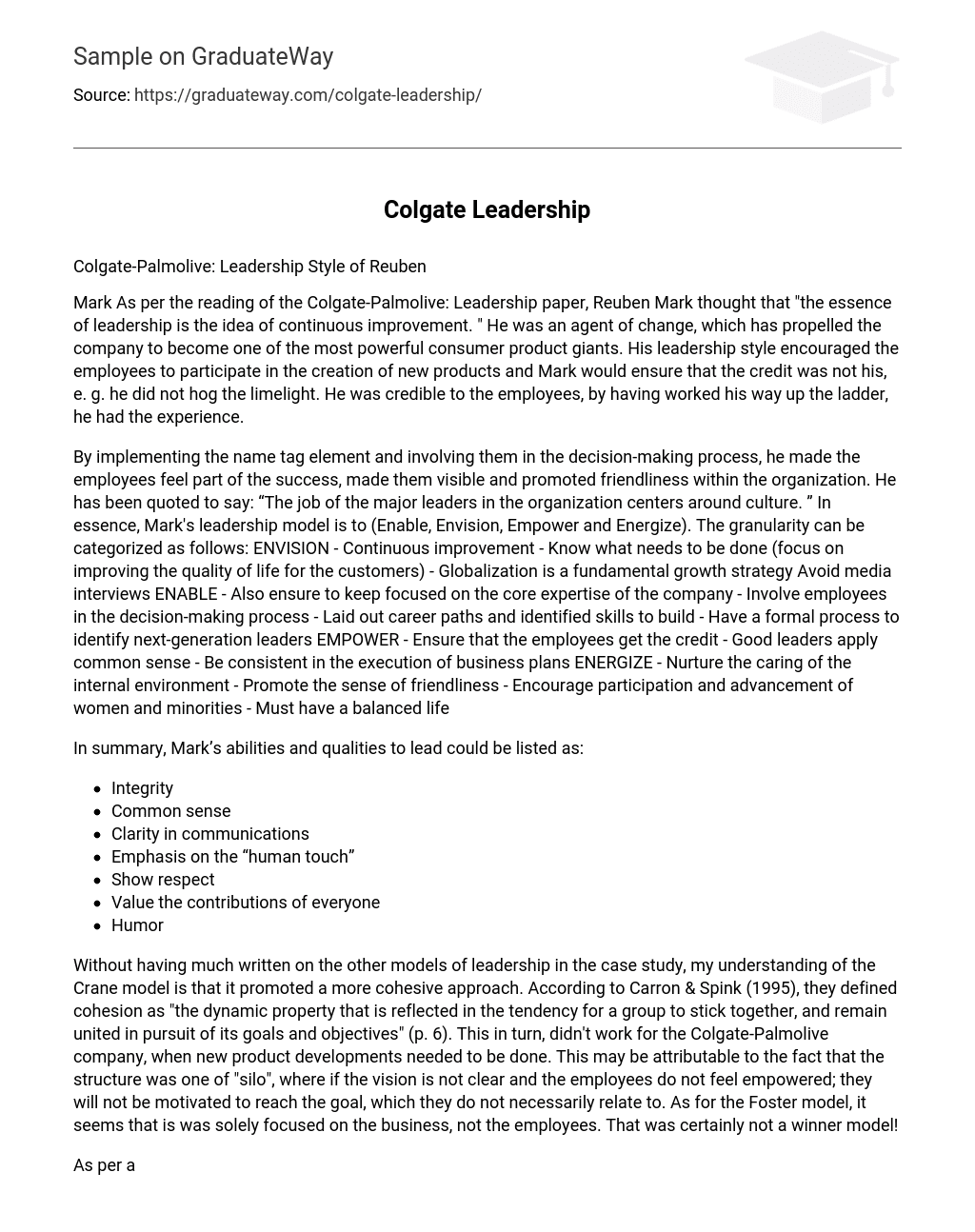Colgate-Palmolive: Leadership Style of Reuben
Mark As per the reading of the Colgate-Palmolive: Leadership paper, Reuben Mark thought that “the essence of leadership is the idea of continuous improvement. ” He was an agent of change, which has propelled the company to become one of the most powerful consumer product giants. His leadership style encouraged the employees to participate in the creation of new products and Mark would ensure that the credit was not his, e. g. he did not hog the limelight. He was credible to the employees, by having worked his way up the ladder, he had the experience.
By implementing the name tag element and involving them in the decision-making process, he made the employees feel part of the success, made them visible and promoted friendliness within the organization. He has been quoted to say: “The job of the major leaders in the organization centers around culture. ” In essence, Mark’s leadership model is to (Enable, Envision, Empower and Energize). The granularity can be categorized as follows: ENVISION – Continuous improvement – Know what needs to be done (focus on improving the quality of life for the customers) – Globalization is a fundamental growth strategy Avoid media interviews ENABLE – Also ensure to keep focused on the core expertise of the company – Involve employees in the decision-making process – Laid out career paths and identified skills to build – Have a formal process to identify next-generation leaders EMPOWER – Ensure that the employees get the credit – Good leaders apply common sense – Be consistent in the execution of business plans ENERGIZE – Nurture the caring of the internal environment – Promote the sense of friendliness – Encourage participation and advancement of women and minorities – Must have a balanced life
In summary, Mark’s abilities and qualities to lead could be listed as:
- Integrity
- Common sense
- Clarity in communications
- Emphasis on the “human touch”
- Show respect
- Value the contributions of everyone
- Humor
Without having much written on the other models of leadership in the case study, my understanding of the Crane model is that it promoted a more cohesive approach. According to Carron & Spink (1995), they defined cohesion as “the dynamic property that is reflected in the tendency for a group to stick together, and remain united in pursuit of its goals and objectives” (p. 6). This in turn, didn’t work for the Colgate-Palmolive company, when new product developments needed to be done. This may be attributable to the fact that the structure was one of “silo”, where if the vision is not clear and the employees do not feel empowered; they will not be motivated to reach the goal, which they do not necessarily relate to. As for the Foster model, it seems that is was solely focused on the business, not the employees. That was certainly not a winner model!
As per an article in the Knowledge@Wharton, Marks is described as a leader who has worked to move the bell curve towards the right. He compares the company’s performance like a bell curve. The bulk of a company’s activities will fall in the thickest part of the bell curve in the middle. Management’s job is to gradually implement and nurture improvements that will move the entire curve toward the right, Mark has suggested: “It’s not romantic and not revolutionary or headline-getting, but over time, that’s what generates success”.
As I must lead in my current position at work, Mark’s is a great example where the team has a whole is mostly important, and he also had a vision to which he has been loyal. He has led the team and the company to success and I will take his advice from the reference article where Mark’s stressed that despite the importance of focus in business, it is also crucial to maintain balance. “You will be a far better professional in all respects if your life is balanced”.





